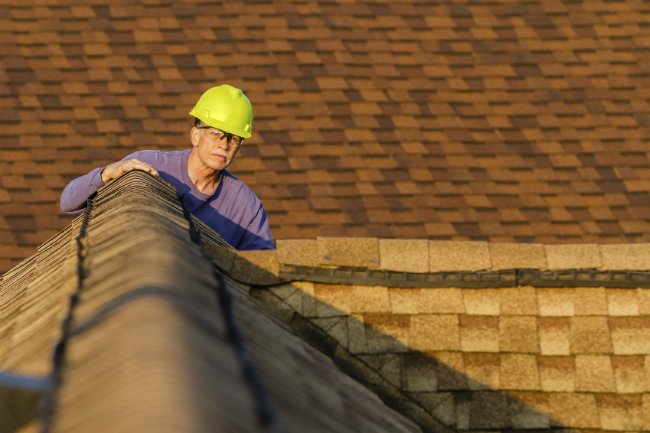

We may earn revenue from the products available on this page and participate in affiliate programs. Learn More ›
Your home’s roof is its first line of defense against storms and extreme weather, be it a foot or more of snow dropping from the sky overnight or high winds that tear through the town. When homeowners place blind faith in their roof and neglect it completely until the first sign of a leak appears in the ceiling, they could already be facing much larger problems—unwanted structural issues, mold growth, or damaged insulation, for starters. Spare yourself a headache down the road by having your roof periodically inspected.
When to Schedule Roof Inspections
After a hailstorm or other significant weather event, most homeowners recognize the need for a thorough roof inspection to determine whether their roof suffered damage. But that shouldn’t be the only time you consider your roof’s health.
Perhaps the most vital time of year to have your roof inspected is the fall, before the cold of winter sets in. Timing is key. Frigid temperatures can compromise the success of new roof installations and such repairs as shingle replacement because new shingles can’t seal down properly when it’s too cold outside. Moreover, attempting repairs on icy roofs can be treacherous, so roof problems uncovered too late in the season may have to wait until spring to be fixed. Another argument for a fall inspection is the fact that certain roof repairs should be initiated in the fall so they can be completed the next spring—for example, treatment for moss and lichen. The solutions used for either of these invaders can require an extended amount of time to work, sometimes up to 180 days. If moss or lichen are discovered during a fall roof inspection, there’s still a chance to get at them before cold weather sets in. Then, the treatment can be working during those long winter months, and the dead lichen can be swept or rinsed off in the spring.

Homeowner Inspections vs. Professional Inspections
Most homeowners can spot obvious roof problems, such as missing or flapping shingles, without climbing on the roof. Other types of damage, however, are not as visible to the untrained eye, which is why it’s important to get a professional opinion. If your roof is relatively new (less than five years old), shows no signs of interior leaks, and hasn’t been exposed to major weather events since the last time it was inspected, you can probably get by with a visual inspection from the ground and a quick check for leaks in your attic. In any other case, however, a comprehensive roof inspection should be completed by a roofing professional who knows what to look for.
For seasonal roof inspections, especially if your roof is more than 10 years old, call a reputable roofing contractor to come out and take a look. If you’re going into a roof inspection thinking that your roof has been damaged in some way, call your insurance company—they might cover the cost of repairs. Your agent will arrange for a qualified roof inspector to examine the roof and make a determination.
What to Expect from Professional Roof Inspections
A roof inspector will be looking for leaks, unusual wear and tear, damage caused by windblown debris, organic growth issues, and problems that may have occurred during shingle installation or subsequent repairs. Ultimately, a roof inspection gets broken into four facets: structure, materials, interiors, and workmanship.
- Structural Inspection: The inspector will check for uneven roof planes and signs of sagging, in addition to examining the condition of the soffit, fascia, and gutter system. Masonry chimneys should be inspected at this time for cracks, crumbling grout, and damage to chimney caps. The inspector may also check the venting in your attic; improper venting can lead to heat and moisture buildup that reduces roof life and increases the risk of ice dams forming at the roof’s edge.
- Material Inspection: Here, the inspector will be looking for loose, missing, or curling shingles; stains; moss; rust; and missing flashing or fasteners. Shingle aggregate that has settled in roof valleys or on the ground at the bottom of gutter downspouts is a sign that the roof could be near the end of its useful life. The inspector will also check the rubber boots and seals around vent pipes, looking for gaps or deterioration.
- Interior Inspection: Because roof leaks ultimately damage your home, the inspector will check interior ceilings, the attic, and interior walls for water stains, mold, rot, and other signs that water is making its way into your house.
- Workmanship Inspection: A thorough inspector will examine your roof for problems in workmanship that could increase the risks of leaks or other roof damage in the future. Incorrect flashing around roof penetrations—including vent pipes, skylights, and chimneys—would all be red flags.
Roofing Analysis
After the inspection, you’ll receive a detailed report about the condition of your roof and what repairs, if any, are necessary to keep it in good shape. If repairs are necessary, schedule them as soon as possible—before the snow flies, if you can. That way, when snow blankets the neighborhood, you can be confident that your roof is in good shape.
